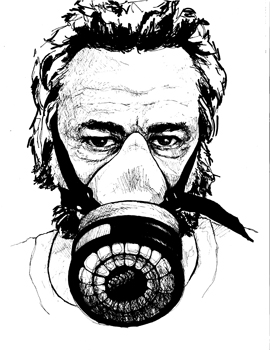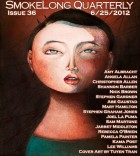How did the idea for this story come about? Were you like, “A doctor who doesn’t like blood! Now that’s a crazy idea!”?
When you put it like that, it sounds kind of cheesy. But, yes. One of the ways I generate ideas is by just thinking of an interesting first line and going from there. “The new doctor was afraid of blood” suggests tension and mystery to me, and the pool and the brother soon arrived to help resolve both.
Sorry, I didn’t mean to make it sound cheesy. I actually think it’s a really cool idea—medical stuff is always tense and mysterious. Speaking of, what’s been your worst hospital or doctor experience?
Two words: barium enema. Still, the good thing about the hospital experiences I’ve had—either for myself or my loved ones—is that, despite the pain, the worry, the grief and the bills, the people have been exceptional. (If you’re wondering more about the barium enema, I plan on writing a thoroughly embarrassing essay about that experience sometime. Title suggestions welcome.)
So, I feel like I once read a horror story where one person gets trapped in an empty swimming pool and can’t reach the ladder to get out. But I have no idea who wrote it or what else happened. My point is, the image of the empty pool, and of the brother diving in, is such a wonderfully jarring and horrible image in this piece. Where did it come from?
I’m pretty sure I ripped off the empty pool from a horror movie I saw when I was a kid. As I remember it, this girl was a diver in the habit of going out each morning before sunrise for diving practice. The killer broke a few lights and drained the pool the night before. I hadn’t thought of this movie in years. In fact, I didn’t consciously remember the movie until I was nearly finished with the story.
How much do you love Ernie’s art to accompany this story?
Tons. The smiling skeletons creep me out in the best kind of way.
Do you mostly write flash, or are you working on a longer project right now?
Yes, I am working on longer stories now as well. I tend to work at flash and short stories very differently, and in trying to come up with a theory of why, I thought about a magazine called National Geographic World that I used to read back in the early 1980s. World was aimed at kids and had a lot of cool science-y stuff in it. But on the back cover they had a feature called “What in the World?” There were nine photographs arranged into a grid. Each photograph was an extreme close-up of some object or animal—sometimes an eye, sometimes the tiny teeth of a zipper magnified 20 times. The reader was then challenged to guess what these objects were. It soon became my favorite part of the magazine. You couldn’t know what the objects were, you had to use your intuition to get a sense of the whole.
I see flash fiction in a similar way. If you want a whole picture, read a novel. A short story might be likened to a close up. But flash fiction is a sort of distorted mystery. As in a blown up photograph of a seed, each detail becomes more important because of the lack of context and familiarity. As a result, my shorter pieces tend to be more experimental, more absurd with more jarring juxtapositions. But the great thing is that this absurdity and attention to detail can seep into my longer stories, strengthening them, even if the end effect is different.




 The core workshop of SmokeLong Fitness is all in writing, so you can take part from anywhere at anytime. We are excited about creating a supportive, consistent and structured environment for flash writers to work on their craft in a community. We are thrilled and proud to say that our workshop participants have won, placed, or been listed in every major flash competition. Community works.
The core workshop of SmokeLong Fitness is all in writing, so you can take part from anywhere at anytime. We are excited about creating a supportive, consistent and structured environment for flash writers to work on their craft in a community. We are thrilled and proud to say that our workshop participants have won, placed, or been listed in every major flash competition. Community works.